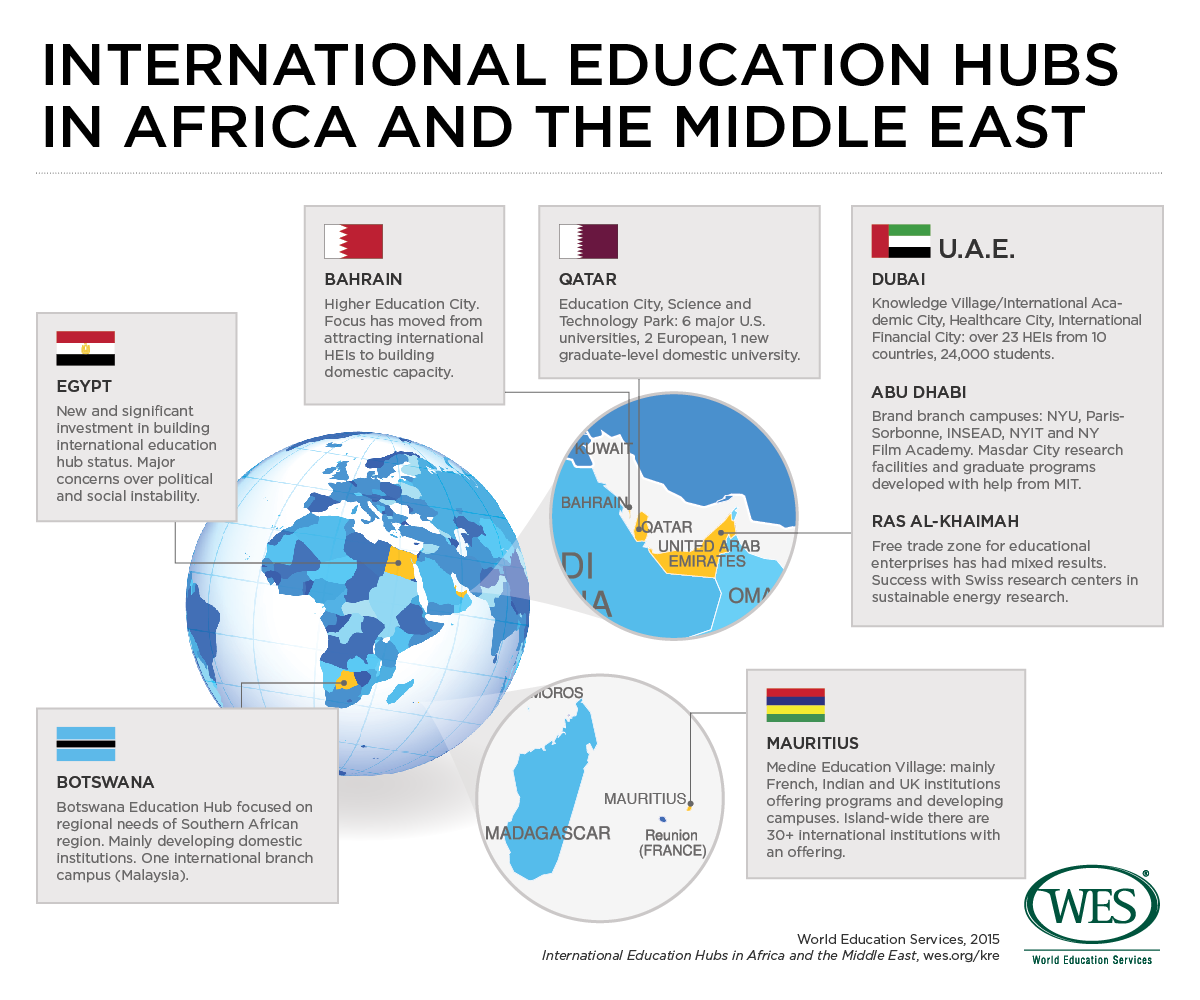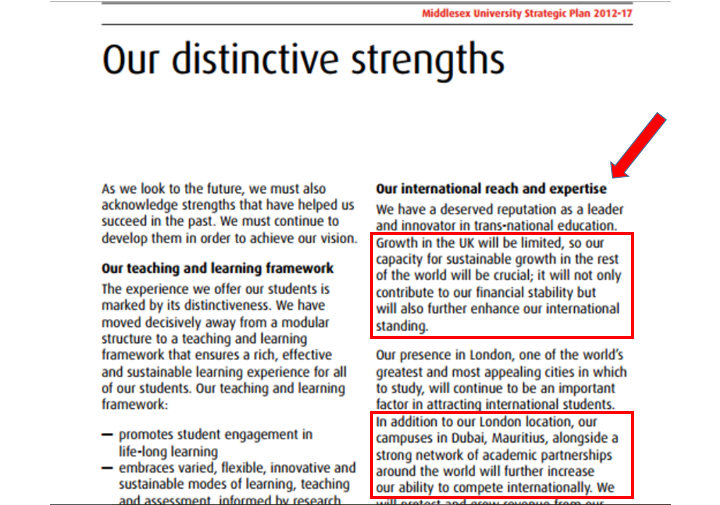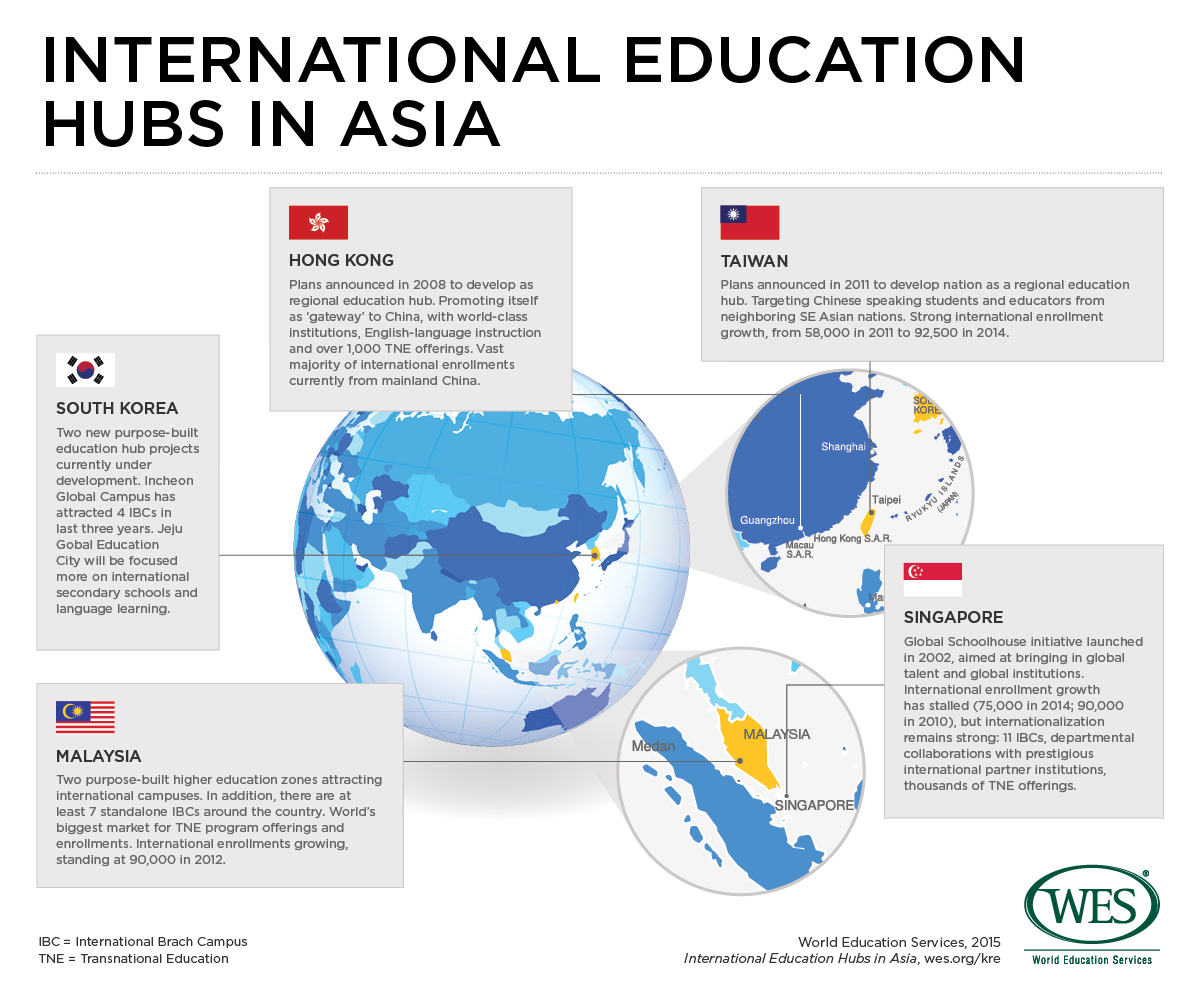 Colleges and universities have been using branch locations to reach and recruit new students for decades, often with slightly modified program offerings, depending on local demand. But what about setting up a full-fledged, full-service university branch overseas as a strategy for international recruitment and transnational brand-building? Seem a bit far-fetched?
Colleges and universities have been using branch locations to reach and recruit new students for decades, often with slightly modified program offerings, depending on local demand. But what about setting up a full-fledged, full-service university branch overseas as a strategy for international recruitment and transnational brand-building? Seem a bit far-fetched?
Actually, overseas university branches are growing in popularity, delivering degrees and diplomas to students who would otherwise be unwilling or unable to travel abroad. But top schools aren’t just “branching” out independently, anywhere. They are often joining what are known as “education hubs” – specially designated zones or regions that are dedicated to knowledge production, innovation, and training to both domestic and international students.
US and UK institutions are the primary contributors to international education hubs. So what’s prompting them to move overseas rather than concentrating on attracting increasingly mobile students to their home campuses? Let’s take a look at the emerging new world of education hubs and how they might impact your school’s approach to international student recruitment
WHAT ARE EDUCATION HUBS & WHERE ARE THEY LOCATED?
An education hub can consist of hundreds of school campuses, businesses, professional development and corporate training organizations, etc., all brought together in one designated region to attract students, and increase its competitiveness on the global stage.
What is the long-term goal for regions who setup educational hubs? According to Jane Knight (Ontario Institute for Studies in Education, University of Toronto), countries currently investing in education hubs “are trying to build a critical mass of local and foreign actors—including students, education institutions, companies, knowledge industries, science and technology centers—who, thorough interaction and in some cases colocation, engage in education, training, knowledge production, and innovation initiatives.”
Sometimes, education hubs operate within a particular “theme”, such as the Dubai Knowledge Park (DKP), which specializes in human resources and business training. The DKP is a one-stop destination for anyone interested in this type of training, offering programs at internationally reputed institutions (which have established branch campuses there), plus the professional services of a wide range of HR agencies.

The Dubai Knowledge Park identifies itself as the “the world’s only free zone dedicated to human resource management and learning excellence”, its chief goal to “develop the region’s talent pool and establish the UAE as a knowledge-based economy.” Like many hubs, the DKP seamlessly integrates players from both education and industry markets.
We see quite a few familiar brands on the DKP’s long list of educational and professional partners, including branches of the University of Manchester, Middlesex University, and Michigan State University:
Education hubs have actually been around for a number of years now, with Singapore’s “Global Schoolhouse” initiative often credited as the trend-setter. In 2002, Singapore set out to attract foreign educational institutions, international students, and international faculty with the goal of establishing itself as a hub for tertiary education and cutting-edge research.
More thematically diverse than the Dubai Knowledge Park, Singapore’s hub plays host to 11 branch campuses, a wide range of impressive domestic institutions, and has forged partnerships with prestigious schools across the globe – including the Massachusetts Institute of Technology (MIT), Duke Graduate Medical School, and Yale University.
The Global Schoolhouse has also attracted a high number of international primary and secondary schools, which currently total 80 in number, with many more in planning and development.
Here’s a quick look at another example – Mauritius’ new hub, called Medine Education Village, which was launched in 2012 with the primary goal of increasing international student recruitment from Africa, as well as local enrollment. Medine calls itself a “smart city in the making”, blurring the line between campus and metropolis, with 9 hectares of land and over 30 participating institutions.

But Dubai, Singapore, and Mauritius are just the tip of the iceberg. Many other locations in Asia, the Middle East, and Africa are quickly emerging as thriving international educational hubs. Here’s a snapshot of this growth, courtesy of World Education Services (WES):

 HUBS & THEIR IMPACT ON TRADITIONAL STUDY ABROAD DESTINATIONS
HUBS & THEIR IMPACT ON TRADITIONAL STUDY ABROAD DESTINATIONS
What’s driving the development of educational hubs across Asia, the Middle East, and Africa?
There are several contributing factors:
- A fast-growing middle class in places like Sri Lanka, China, Vietnam, India, Uzbekistan, and Indonesia is enabling greater regional mobility
- Within the next 10 years, India, Ethiopia, Nigeria, and Indonesia are expected to lead the world in numbers of 18 to 22 year-old prospective students
- Countries with increasing numbers of potential post-secondary students are interested in retaining those students, and attracting others from neighboring regions, with enhanced educational resources
Hub regions are looking to bolster their own economies by investing in human capital, attracting foreign branch campuses, forging articulation partnerships with foreign universities, and collaborating with industry – all designed to cultivate and produce talent and effectively brand themselves as ultimate study “destinations.” So what does this mean for traditional study abroad destinations?
According to the 2015 International Trends in Higher Education report from Oxford University, the United States and the UK (two of the world’s top destinations for international students) will steadily lose market share over the coming years. Meanwhile, intraregional study abroad (students who travel to nearby regions, such as hubs) is expected to grow.
In order to tap into the intraregional market, some Western universities are establishing branch campuses abroad, hoping to reach the growing segment of students who want the prestige of an internationally recognized diploma without the strain of relocation.
Middlesex University is one such school, and an early adopter of the branch model. This excerpt of their Strategic Plan 2012-2017 acknowledges that “growth in the UK will be limited” and that transnational initiatives (in the Dubai and Mauritius hubs) will be key to supporting international student recruitment.

While attracting students from abroad will remain important and indeed lucrative for schools in traditional destinations like the US, UK, Australia, and Canada, market trends are nonetheless indicating a potential shift in priorities – and opportunities – for burgeoning populations of college-aged people in key regions across the globe.
We see institutions like the University of Manchester edging ahead of the curve by setting up branch campuses in several of these key hub regions in Asia and the Middle East, and promoting these access points on their web pages:

On the Dubai Knowledge Park partners page, we note that the University of Manchester calls itself the “Manchester Business School Worldwide” highlighting its movement away from a UK-centric identity toward a transnational brand, capable of delivery the same, consistently high quality programs at multiple locations across the globe. This doesn’t mean some students won’t still travel to Manchester to earn their degree (and experience a new culture), but such travel is no longer mandatory for students who live in or near participating education hubs.
Ultimately, and if it can sustain the branch campuses, the Manchester Business School will reap the benefits of diversifying its approach, and tapping into multiple “segments” of the international student population.
CHALLENGES OF SUSTAINING A UNIVERSITY BRANCH OVERSEAS
It must be noted that setting up a branch campus in an international hub is not always smooth sailing, and does not necessarily guarantee a boost in international student recruitment. Several high-profile American, UK, and Australian international branches have closed up over the last several years, including John Hopkins in Malaysia. According to the previously cited Oxford University report, a number of factors contributed to these failed attempts, including economic and political upheaval, changing government policy, and the withdrawal of support from the host region or country.
In some cases, trouble arose from within the home institution to disrupt operations at the branch, such as with Yale University and New York University, whose own faculty resisted this kind of transnational expansion. Several reasons were cited, including concerns that investment in branches would reduce the quality of education at home, and reservations about the political climate surrounding new branch locations. Indeed, not all education hubs operate with the same level of academic freedom, and in certain areas, professors and researchers have complained about censorship.
There are also pedagogical challenges to delivering programs from a branch campus within an international education hub abroad. One of the main concerns is that branch campuses, being mainly satellites of US and UK-based institutions, will disseminate Western-oriented, Eurocentric curricula to audiences across the globe, thereby engaging in a kind of educational colonization. Like with any expansion project, measures must be taken to protect and promote local culture, which means ensuring course materials and program delivery methods are regionally relevant.
Despite these challenges and past failed endeavors, university branch campuses in hubs across the globe are a growing in number – at this point they reach nearly 220 worldwide.
Some experts see the proliferation of campus branches and the growth of education hubs as the natural evolution of transnational education. Hub researcher Jane Knight observes, “There is no doubt that education hubs are an evolving and complex phenomenon.” However, Knight also cautions that “the absence of reliable data or in-depth study on their planning and operation limits a solid understanding of their role, evolution and accomplishments”.
So it remains to be seen whether hubs are merely a passing fad, or destined to become a standard component of international student recruitment – for schools of all shapes and sizes.
What do you think? Would you launch a branch campus in an education hub overseas? What challenges or opportunities would this create for your school?
Feel free to share your views in the space below.









